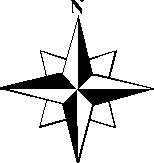Is it true that ..."The First Tree From North" is a "Random Tree?"No. Far from it. Generally speaking, this method tends to favor trees on the outside of clumps, and ones which are isolated. It might be convenient, but it sure is biased in the sense that each of the trees do not have an equal chance to be picked.
How much does this bad process bias the results? Nobody knows – and perhaps that is the point. "Unbiasedness" does not mean lack of criminal intent. It means that the process actually accomplishes the job. The issue here is not intent – the issue is correctness of procedure. If you want to choose one tree randomly (with equal probability) from the ones that are "in" with your prism sweep or fixed plot, take the time and do it right. Number the trees in any order you want, then choose a random number between 1 and the total of trees in the group. This will choose trees randomly and with equal probability. The random number generators on hand calculators are adequate for this purpose. For check cruising purposes you might want to specify how the crew numbers the trees and give them a list of random numbers to use before they go to the plot. A quick comparison of this correct process with the "first tree" answers on 100 plots would be exceedingly interesting, and anyone who keeps using this biased procedure should be able to produce such evidence if they believe the answers "are not very different." Otherwise, it is just another myth that serious people should abandon before they get embarrassed. Does this give every tree in the cruise an equal chance of being picked? No, it does not. If you only had one tree at a sample point it would always be picked, and if you had 5 trees they would have a 1/5 chance of being picked. Is this a problem? Not necessarily, since you could weight the results based on how many trees you picked from. You need to think about whether trees should be chosen with equal frequency. In some instances, one tree per plot or point might be appropriate, but not often. To insure that each tree in the cruise has an equal chance of being picked, you should label the trees as before, but now at each plot you pick a random number between 1 and some FIXED number (say 20). If the random number does not match one of your trees, you do not take a sample there. If you repeat the selection process several times at a point and the tree comes up repeatedly you simply write it down several times. Is there any reason to panic if you have been using this procedure? No, probably not. But perhaps it is time to kill this field procedure and replace it with something better. The business does not particularly profit by poor processes like this. |
 There are a
number of ways to check the amount of this bias using
stem mapped plots, and such a comparison would be a good
practical research topic for a student somewhere. If you
go to court, however, the judge is unlikely to be
impressed with this obviously biased method on the basis
that you simply believe the answer is good.
There are a
number of ways to check the amount of this bias using
stem mapped plots, and such a comparison would be a good
practical research topic for a student somewhere. If you
go to court, however, the judge is unlikely to be
impressed with this obviously biased method on the basis
that you simply believe the answer is good.